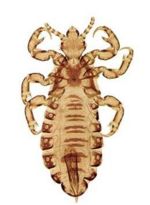Lice
| This article has been peer reviewed but is awaiting expert review. If you would like to help with this, please see more information about expert reviewing. |
|
|
Phthiraptera Introduction
Lice are obligate ectoparasites of every avian and most mammalian species. They are only a few millimeters long and like fleas, are wingless but unlike fleas are dorsoventrally flattened.
Lice are host specific, permanent parasites which cause pediculosis. The louse saliva and faeces contain allergenic substances which cause irritation, rubbing, licking and skin damage leading to decreased host productivity.
Mammalian lice species have a single pair of claws on the ends of stout legs, whereas avian lice species have a double claw on each leg.
There are two main groups of veterinary importance, the mallophaga (chewing lice) and anoplura (sucking lice).
Mallophaga
Also known as chewing lice or biting lice
- Broad head
- Thorax narrower than the head
- Rasping mouthparts
- Feeds on epithelial scales, scabs, feathers and other bodily debris
- Species occur on both mammals and birds
Anoplura
Also known as sucking lice
- Narrow head
- Thorax wider than the head
- Powerful legs
- Piercing mouthparts
- Feed on blood and tissue fluids
- Heavy infestations can cause anaemia
- Species occur only on mammals
Life Cycle
- The whole life cycle takes 2-3 weeks
- The louce spends its whole life on the animal
- But, can survive for one week off the animal
- In some species parthenogenesis can occur
- Close contact transmission can occur
1. Eggs
- Known as nits
- Cemented to hairs
2. Nymphs
- Nymphs hatch from the egg (no larval stage)
- Undergoes several moults
3. Adults
- Females can lay up to 10 eggs per day
Pediculosis
- Pediculosis is an infestation of lice
- Pediculosis in farm animals in most usually seen in winter when the coat is thickest
- Debilitated animals are often lousy as they cannot groom properly
Cattle
- One chewing louse
- Bovicola bovis
- Several sucking lice
- E.g. Linognathus vituli
- Most lice have a preferred predilection site on the body
- Some lice will gather in clusters
- Causes ill-thrift, anaemia and can lead to down-graded leather
Sheep
- One chewing louse
- Damalinia ovis
- Two sucking lice
- Lignognathus spp.
- The 'foot louse' and the 'face louse'
- Lignognathus spp.
- Causes fleece damage
Pigs
- One sucking louse
- Haematopinus suis
- Large 5mm louse which is easily visible on the skin
- Vector of African swine fever virus and rickettsiae
Horses
- One chewing louse
- Damalinia equi
- One sucking louse
- Haematopinus asini
- Mainly in the mane and tail but can spread over the body
Dogs
- One chewing louse
- Trichodectes
- One sucking louse
- Linognathus setosus
- Neglect is usually associated with heavy infestations
Cats
- One chewing louse
- Felicola
Poultry
- Several species of chewing lice
- Lipeurus spp. are the most pathogenic
- E.g. the 'wing louse' and the 'head louse'
- Menacanthis spp. are also pathogenic
- Lays its eggs in clusters around the cloaca
- Lipeurus spp. are the most pathogenic
- No sucking lice
Control
- Few insecticides will kill lice eggs on the animal
- Two treatments are needed to kill nymphs emerging from eggs at the time of the initial treatment and those that will emerge 2-3 weeks later
- At two week intervals
- Or a product with a two week residual activity can be used
Anopleura lice are more susceptible to systemic insecticide treatment than mallophaga lice
- Resistance to insecticides may become a problem so alternating the chemicals used and avoiding pour on treatments (which have a greater risk of resistance developing) should be considered

